Nestled deep in the heart of the South Pacific, forming a triangle with Fiji’s two larger islands of Viti Levu and Vanua Levu, Taveuni stuns and begs you to stay even longer than you anticipated.
Taveuni is the third-largest island in the Fijian archipelago and is often referred to as the ‘Garden Island’.
And with good reason — Taveuni is a lush, green paradise complete with cascading spectacular waterfalls and scenic hikes that beckon adventurers and tranquility seekers alike.
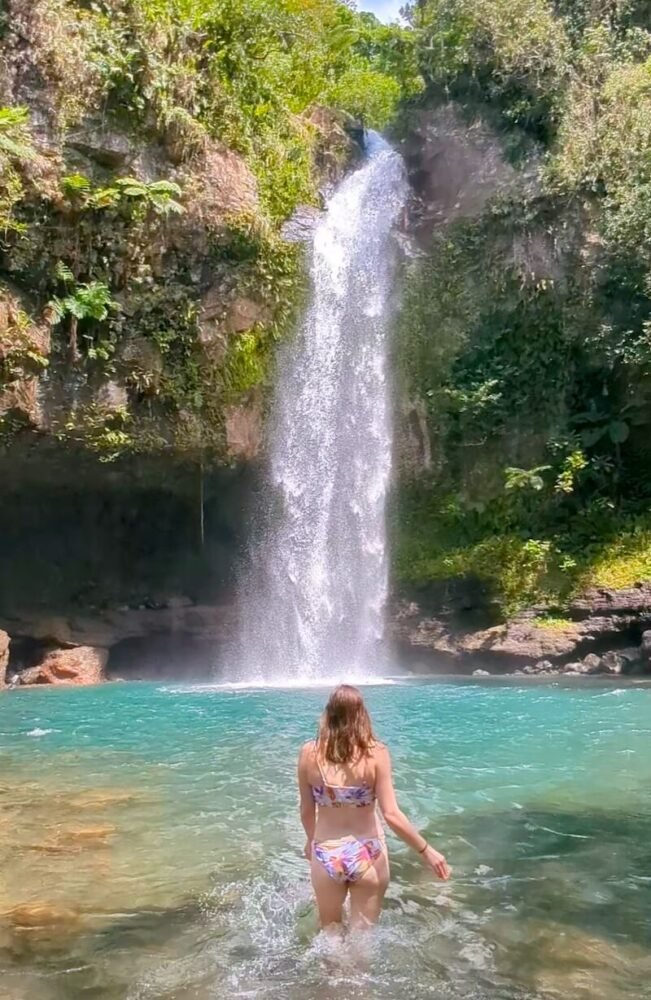
But for many people, the real draw to Taveuni is what lies beneath the surface.
Plunge into the mesmerizing Rainbow Reef found along the Somosomo Strait, and you’ll be experiencing one of the world’s best dive destinations.
Dive sites like the the Great White Wall and Purple Wall are not just poetic names but promises: an explosion of colors and marine life that will leave you spellbound and overwhelmed in the best possible way.
Getting to Taveuni

Getting to Taveuni by plane is certainly the easiest way to get here, though it’s not the cheapest.
Domestic flights leave several times a day from both Nadi and Suva, and cost around $300-400 USD roundtrip.
If you’re coming from the island of Vanua Levu, you can also take a ferry and bus combination.
The Taveuni Princess passenger ferry fits 50 people and runs the Somosomo Strait, including a bus service to and from Savusavu on Vanua Levu.
It takes about one hour to travel from Savusavu to Buca Bay, and then the ferry crossing to Taveuni takes about 2 hours.
If you’re in Savusavu, you can buy tickets in the bus terminal for about $25 FJD per person (about $11 USD).
If you’re not in Savusavu, you’d have to get there first from Viti Levu, which is possible via several different ferry ports.
27 Best Things to Do in Taveuni for All Kinds of Travelers
Scuba dive the epic Rainbow Reef!
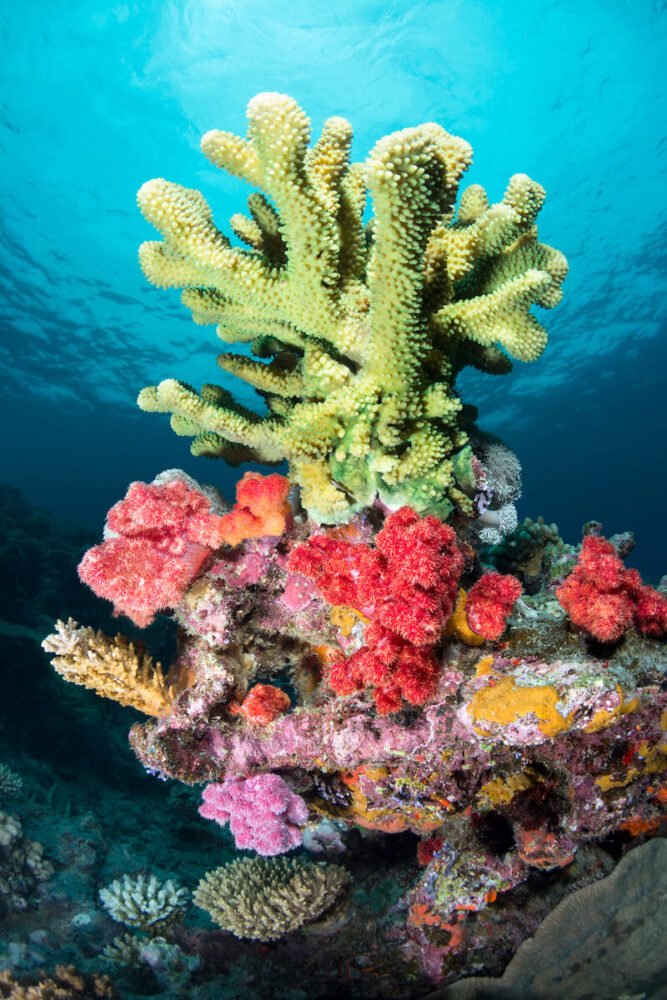
The island of Taveuni is home to one of the healthiest and most stunning reefs in Fiji — and indeed, probably the world!
There’s a reason Jacques Cousteau dubbed Fiji as as the soft coral capital of the world — and in particular, Taveuni’s Somosomo Strait is where you’ll see some of the best soft coral.
Soft coral is dependent on currents to bring the corals nutrients, so they’ll only unfurl and show their true beauty when there’s current.
As a result, diving in Taveuni is an interesting mix of push-and-pull drift driving, slower lulls between coral heads, and occasionally pausing against the current to truly take in the beauty.
Nicknamed the Rainbow Reef for its canvas of vivid hues, there are some 20+ dive sites that each offer something incredible — and I got to experience 9 of them (since we doubled up and did the Great White Wall twice!).
I’ll dedicate a whole section to the Great White Wall next, but there are a few other sites I want to shout out.
One is the beautiful Annie’s Bommie, which is Aussie slang for outcrop of coral reef.
This spiraling coral pinnacle is like a tornado of fish life with fusiliers and purple and orange anthias constantly dancing around it.
As you navigate in slow spirals around this beautiful pinnacle, getting shallower as the dive progresses, keep an eye out for the delicate macro life that often goes unnoticed!

Another great dive site is Enchanted Forest, which doesn’t disappoint its poetic name.
With its lush soft corals, tall sea whips, and forest-green tree-shaped branching corals, it truly feels like an underwater forest.
Another favorite of mine is the Purple Wall. True to its name, it is adorned with rich purple soft corals cascading down a steep wall.
But it also has so much incredible small life, like decorator crabs, black mantis shrimps, and all sorts of nudibranchs!
Time your trip to dive the Great White Wall, one of the world’s best dive sites.

The Great White Wall in Fiji is often hailed as one of the world’s premier dive sites, and having dove it twice, I can attest there’s no other dive site quite like it.
Nestled in the depths of the Somosomo Strait, this incredible wall dive is named not for sharks (luckily!) but for its breathtaking soft corals in otherworldly shades of white and soft, pale lavender.
You’ll go through a swim-through to exit the cave and see a sight in all its splendor – a sheer drop of a coral wall, completely blanketed in luminescent white soft corals, making it seem as if you’re floating alongside a snowy mountainside underwater!
Unfortunately, though, the Great White Wall can only be visited a few times each month, and here’s why: it’s all about the tide.
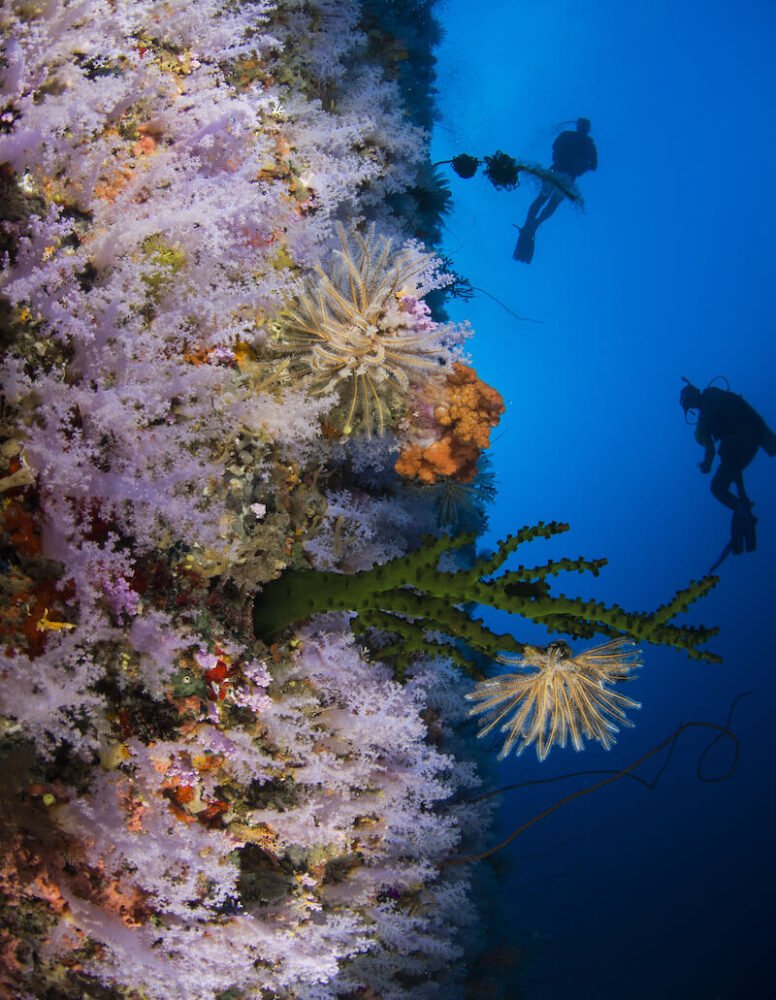
The full bloom of its namesake white soft corals are highly sensitive to water conditions, only blooming to its full potential a few times a month.
Luckily, the dive shops can predict this and plan accordingly, so you can arrange your Taveuni trip to coincide with the wall’s peak bloom.
These specific tidal conditions play a crucial role in nourishing the soft corals, ensuring they flourish and maintain their radiant white hue and their ethereal beauty.
The stark-white and semi-fluorescent hue of the corals, contrasted against the deep blue abyss, creates a surreal experience that you’ll remember for life.
And once the Great White Wall portion of the dive is up — and it goes fast, since you dive at 90-100 feet, so you need to keep an eye on your dive computer to not exceed your NDL — it somehow still feels like it just keeps getting better.
The second portion of the dive features beautiful bommies in every shade of purple and lavender imaginable, rife with fish life and macro critters. I even was lucky enough to spot the magnificent peacock nudibranch here!
In addition to the beautiful soft corals, I also got to see a giant moray eel, an octopus (twice, on two different dives!), and so many incredible fish.
Snorkel along Taveuni’s shallower reefs.
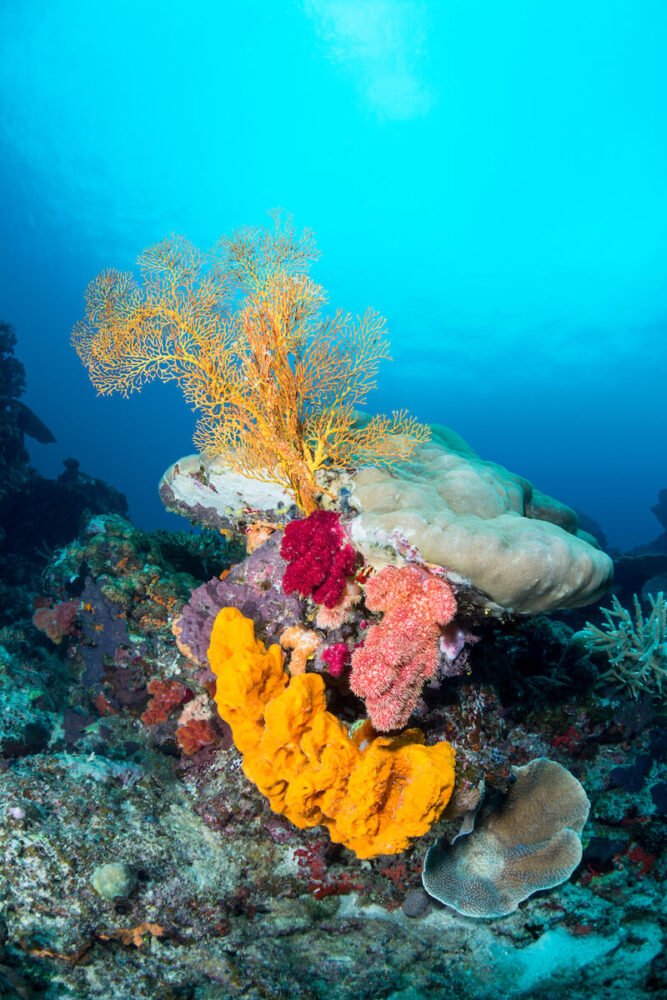
If you’re not scuba certified, don’t worry — the Rainbow Reef is not off-limits to you!
We met a couple at one of the BBQ dinners we attended who don’t know how to dive.
Sure enough, a day or two later we saw them on board our boat, coming out with us to some dive sites where there are shallower areas for snorkeling.
You will want to take a day trip to snorkel in Taveuni, because the Rainbow Reef is a distance away by boat, around 20-30 minutes away. You definitely can’t just get there from shore and see the best of it!
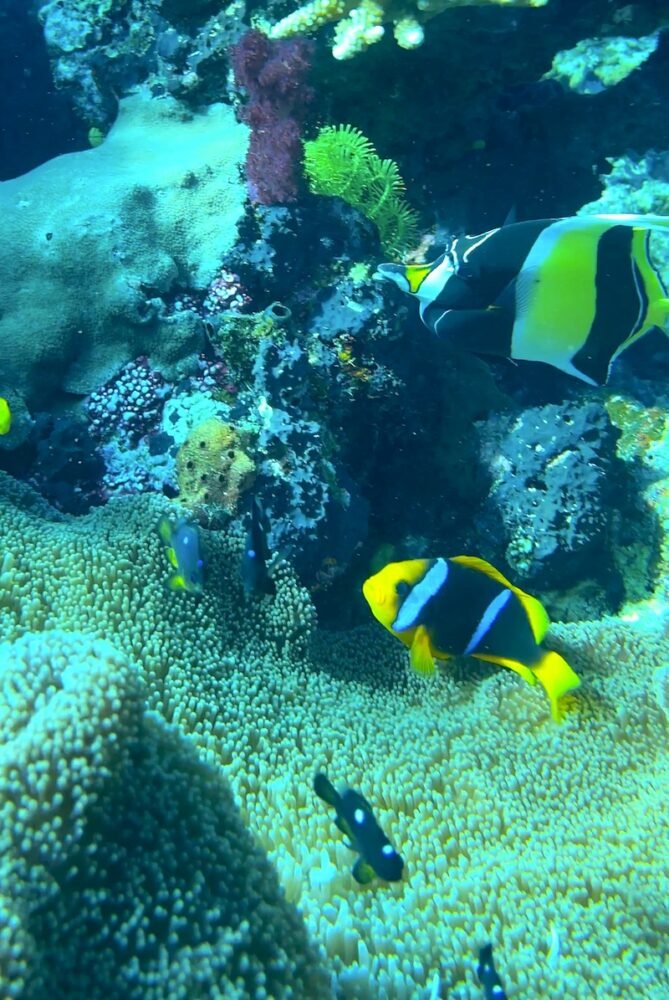
You can arrange a snorkeling trip with Taveuni Ocean Sports and they’ll give you a guide to bring you to the best snorkel spots on the Rainbow Reef.
Some dive sites are situated where there are shallow patches where you can see as much life from the surface as possible.
Expect to see every color of fish and coral possible, and even possibly whitetip reef sharks or turtles!
Typically, the dive sites where they’ll also bring snorkelers are Nuku Reef, Fish Factory, and Cabbage Patch, since these three sites have excellent shallower portions.
Traverse the Lavena Coastal Walk.
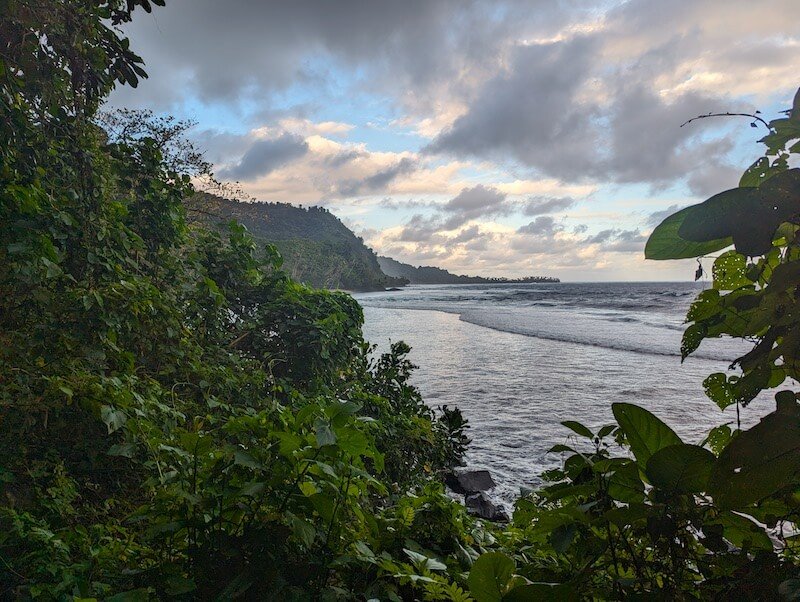
But diving isn’t the only thing Taveuni has to offer, though it may be what the island is most famous for.
No, this beautiful island is also a hikers dream, too!
The Lavena Coastal Walk is one of the best walks in Taveuni, located at the far eastern edge of Taveuni island — quite literally at the end of the road!
This relatively easily 3-mile walk used to be famous for its beautiful suspension bridge, though unfortunately that bridge is no longer after a cyclone came through and wiped it away.
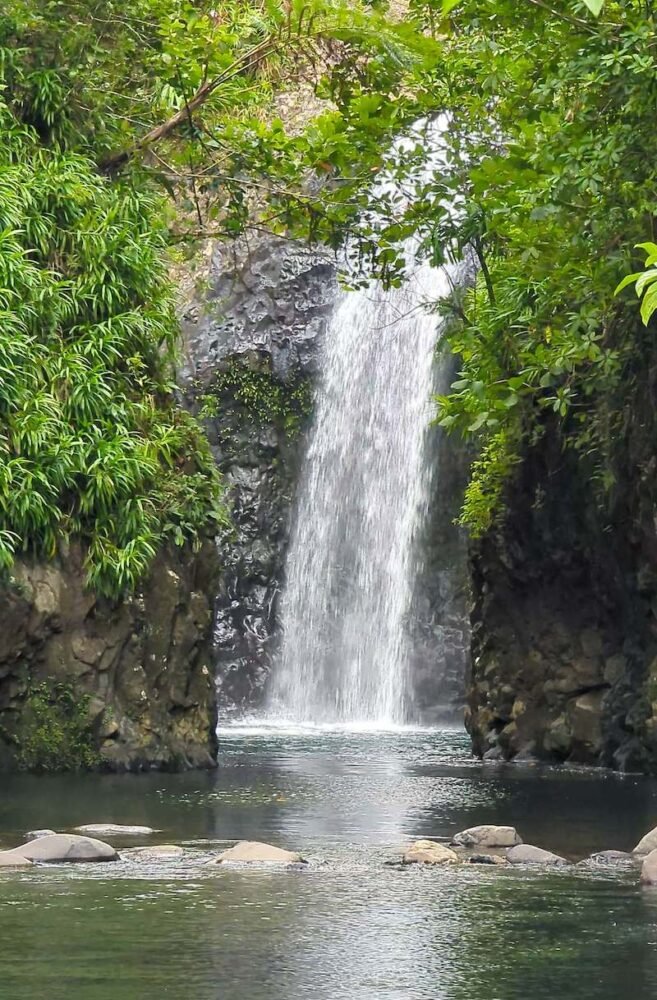
It’s still quite a lovely hike through the coastal forest, though now the suspension bridge has been replaced with a river crossing.
It takes about 3 hours to hike to Wainibau Falls, the waterfall at the end of the Lavena Coastal Walk, a double-whammy of a waterfall with several natural swimming pools you can also take a dip in.
I have a full guide to doing the Lavena Coastal Walk if you want to read that before your trip!
Visit the Lavena Coast by boat to see the coastal waterfalls.
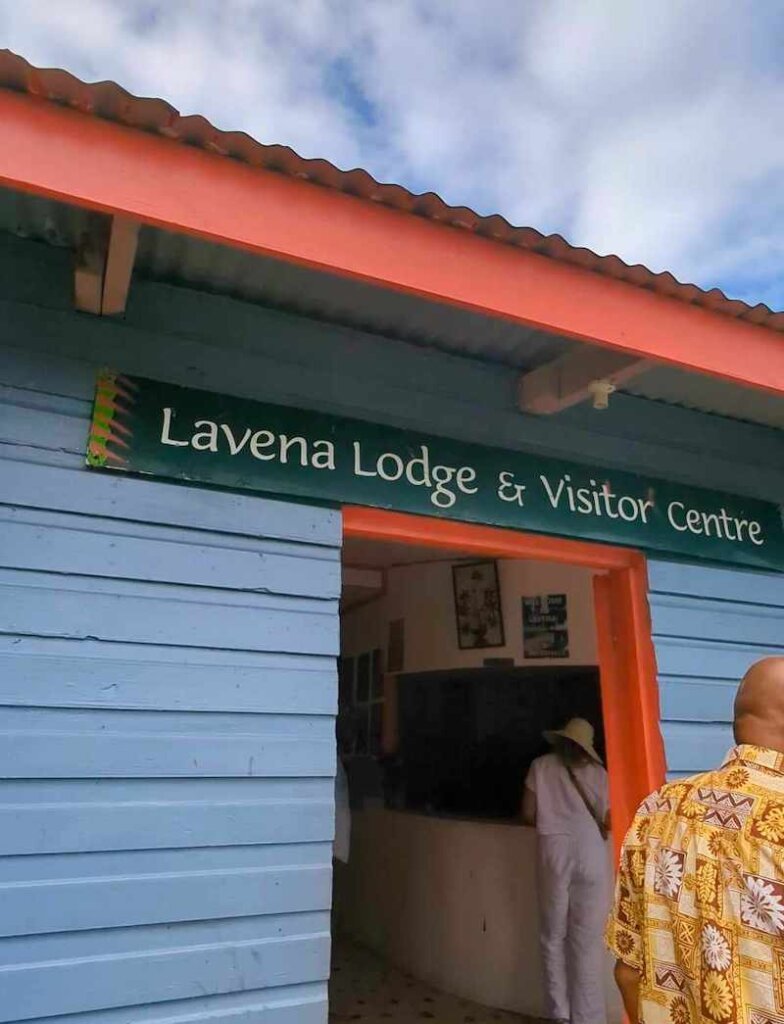
Another way you can visit the waterfalls is by taking one of the boat tours that depart from the visitor center in Lavena.
The basic boat tour to the first waterfall is priced at 165 FJD ($73 USD).
This essentially means you’ll bypass most of the trek to Wainibau Falls that you would do if you took the Lavena Coastal Walk, focusing on the core section that can only be covered on foot.
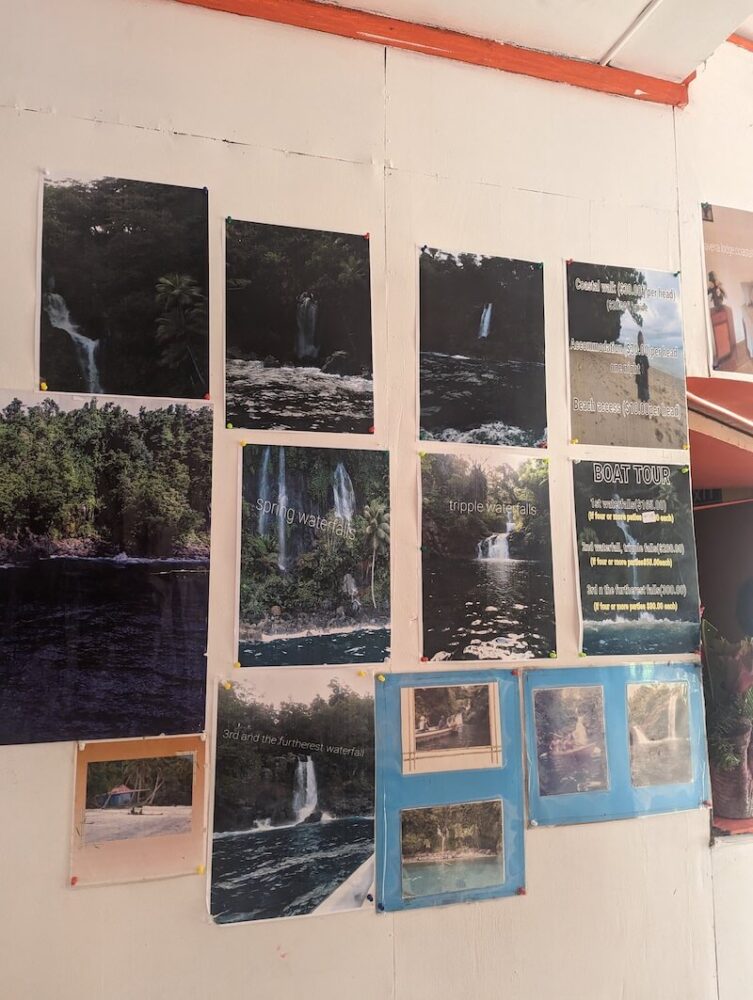
For groups of 4 or more, the rate for this primary boat excursion is 45 FJD ($20 USD) per individual.
Other available options include a tour to the second waterfall, which boasts a trio of cascading falls.
For parties of 3 or fewer, the boat fee is 200 FJD ($88 USD). However, for groups of 4 or more, the cost is reduced to 50 FJD ($22 USD) per person.
The ultimate boat tour option takes you to the most remote waterfalls. For this experience, parties of 3 or fewer pay 300 FJD ($132 USD total), while groups of 4 or more pay 80 FJD ($35 USD) each.
Slide down the Waitavala Waterslides.

One of the most fun things to do in Taveuni is join the locals at the Waitavala Waterslides, located just outside the main town of Somosomo.
These natural waterslides are precisely what they sound like—slick, smooth rock surfaces where streams have carved a path, allowing visitors to slide down amidst a scenic backdrop of Taveuni’s jungly interior.
What’s particularly fascinating about the Waitavala Waterslides is the fun local experience it can be, especially on weekends.
If you want a genuine Fijian experience, visit on a Saturday or Sunday!
This is when local families gather, and joyful shrieks and excited yells echo through the air, as folks of all ages take their turn to glide down the water-eroded slides.
Accessing the waterslides is relatively straightforward. From the main road, there’s a marked trail that leads you directly to this natural wonder, about a 10-minute hike until you reach the waterslides area.
From there, you’ll cross the small river at the place where it’s calm — there’s a handrail that helps you cross. You’ll need to walk about 10 minutes more to reach the start of the slides.
As of my last visit, there wasn’t an official entrance fee to access the waterslides, but we did pay about $70 FJD (~$30 USD) to have a driver bring us there and wait for us for an hour or so while we enjoyed the slides.
A few safety tips: this is a natural waterslide so there are inherently some risks! Keep your head protected so you don’t bang it on any rocks (don’t lean your head back, but stay sitting upright).
Likewise, keep your arms to yourself, crossed across your chest, so you don’t harm your hands or fingers. Also, wear pants so that you don’t get beat up and bruised by the slides!
Hike to the Tavoro Waterfalls in Bouma National Heritage Park.

One of the best hikes in Taveuni is the hike to the Tavoro Falls (also known as the Bouma Falls) in the national park.
Consisting of three separate waterfalls, this is an epic and customizable hike.
You can choose between a short hike to a tall, single-drop waterfall into a beautiful crystal-clear blue swimming pool… or a longer hike to two more waterfalls, including optional river crossings!
Hiking to the first waterfall is rather easy, via a 10-minute walk from the Visitor Center on a paved path.
The next waterfall is definitely harder, requiring another 40 minutes of walk and including an optional river crossing (or you can take a path that doesn’t require one).
The result is an epic, more secluded roaring waterfall that you can swim in or just admire the ferocious spray!
There’s also a third and final waterfall, with the largest natural swimming pool.
This is technically the smallest waterfall, but it cascades across a wide rock, making it rather impressive.
The third waterfall is also about 40 minutes from the prior one, so all in all, expect to walk 90 minutes from the visitor center to the highest one, and then be sure to allocate time to swim in some (or all!) of the pools.
I have a full guide to visiting the Tavoro Waterfalls here.
Watch the sunset from Tramonto in Matei.
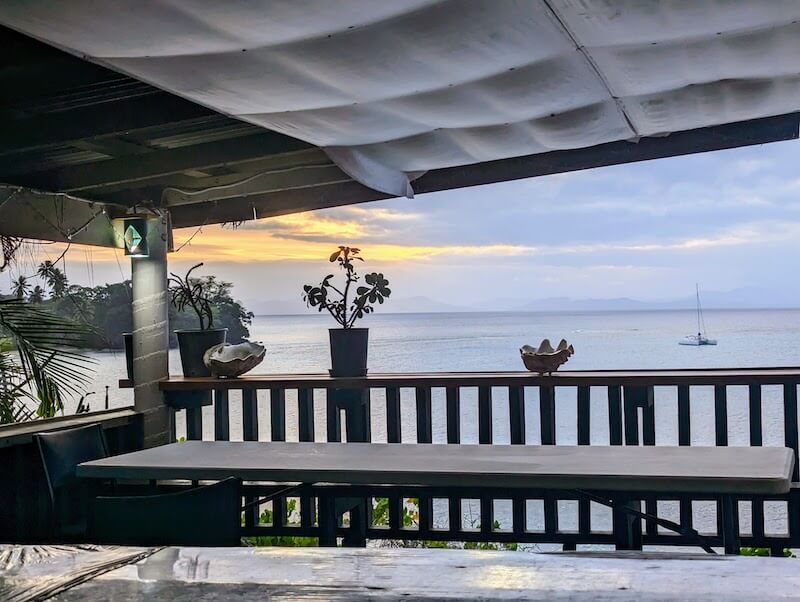
Of course, with all that diving and hiking, you’re bound to get tired and just want to relax with an epic sunset view from time to time, no?
Many of the accommodations in Taveuni are in the town of Matei — and even if you’re not staying there, it’s worth visiting this part of the island if you want a break from your resort’s food.
Tramonto is a beautiful beachfront restaurant that has some of the best sunsets on the island.
They offer a rotating menu every night of delicious local Fijian cuisine — I enjoyed a curry lolo octopus one night that was unreal!
Try Fijian kava with locals.

Kava is an essential part of understanding the Fiji islands’ culture and history.
Once reserved only for war chiefs, now kava has been democratized to be an everyday custom, but one that still has roots in its tradition.
Typically, one person will be in charge of leading the kava ceremony. They are in charge of preparing the kava and serving it to people (and determining the order of serving).
Before you drink, say “bula” — a term of greeting that also works like ‘cheers’ in this context.
People will clap (typically 3 times) as you drink and finish your kava and return the coconut cup to the leader.
Between rounds of kava, typically the leader of the ceremony will also sing songs or let people talk and chat amongst themselves.
But wait, what is kava?
Kava is a relaxing depressant that gives a calm, tingly, relaxed feel due to its kavalactones.
It’s not intoxicating in the sense that alcohol is, but it can give you a slightly euphoric sensation.
Drinking too much super-strong kava can definitely make you weak in the knees, but generally, it’s a rather gentle drink that is fun to enjoy with a group while in Taveuni.
Your hotel will likely offer you the opportunity to try kava, and many ‘lovo nights’ will also have kava served.
Attend a lovo night to try traditional Fijian food.

While Taveuni has many strengths, being a gastronomic powerhouse is not one of them.
I love Fijian food, but the options on Taveuni end up being somewhat few and far between, and you’ll likely tap out all the main restaurants within a few days.
This is where the lovo nights come in to save the day! ‘Lovo’ refers to the traditional Fijian way of cooking in the earth.
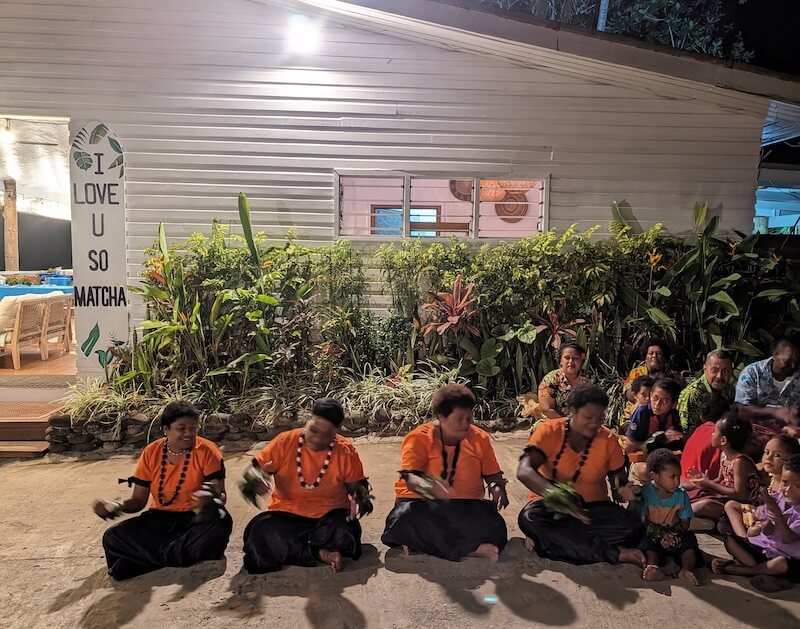
Many lovo nights also consist of a cultural component, such as a kava ceremony or a dance performance from local villagers.
For around $40 to $55 FJD ($18-24 USD) per person, you can enjoy a buffet of Fijian cuisine, including earth-cooked BBQ dishes like a whole wahoo fish!
You’ll also try other favorites of Fijian food, like kokoda (a ceviche-like raw fish dish served with coconut milk and citrus) and the pumpkin-cooked stews.
They also serve unique Fijian sides and veggies like steamed cassava leaves, lovo-baked breadfruit, and ota, a young fern.
This is a great way to try a bunch of different Fijian dishes that are often hard to order at restaurants, which tend to offer a more Western selection of food.
Typically, the Dive Café hosts a lovo night on Wednesdays and the The Drift hosts a dinner on Fridays or Saturdays.
Enjoy the best breakfast on the island at The Dive Café.

Like I said, there aren’t too many choices when it comes to food on Taveuni…
… but when it comes to where to get a delicious breakfast, the obvious answer is the Dive Café in Matei.
They have delicious coffees — the best coffee I had in my entire two weeks in Fiji!

They also have options like chai lattes and matcha lattes for those of us who want a little caffeine but don’t love coffee.
Their breakfasts are fantastic, including veggie omelettes and delicious pancakes.
They also have a ton of different smoothie options if you want something a little healthier!
Plus, its beachside setting is adorable!
Eat delicious organic ice cream from a stall.
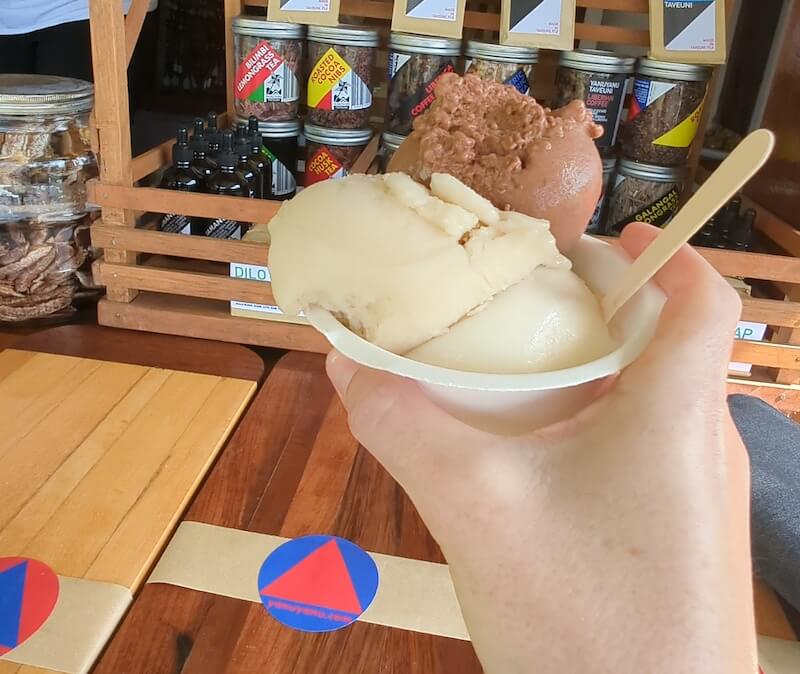
Located not far from the Matei airport in front of the Coconut Grove Beachfront Cottages, you’ll find the best ice cream — all organic! — on Taveuni.
With a rotating cast of unique flavors, the ice cream only costs $2 FJD per scoop (less than $1 USD), making it nearly impossible to leave without trying at least three flavors.
I tried their chocolate and coconut, as well as a lemongrass flavor, and a soursop flavor — all of them were stunning!
Sample local organic chocolates.

Also at this stall, you can pick up some locally-made organic chocolates which also make perfect souvenirs from Fiji.
There are samples you can try — once you try it, it’s hard not to leave without a few bars!
Stay in a lovely bure in Matei.

There are a handful of great resorts in Taveuni, but you can also just enjoy a more casual stay in one of the bures (bungalows) on the island.
With high, vaulted ceilings with thatched roofs and an ingenious design that maximizes cross-breezes, these bures are a wonderful way to get a sense of Fijian design.
These bungalows utilize the environment to its advantage, blending architectural elements to make an eco-friendly accommodation choice.
In fact, they’re so well-designed we never once had to turn on the air conditioning during our entire week in Taveuni!
We stayed at Maravu Lodge in Matei and loved their bures, and the prices are really affordable.
Rent a kayak or SUP and explore the calm coast of Matei.
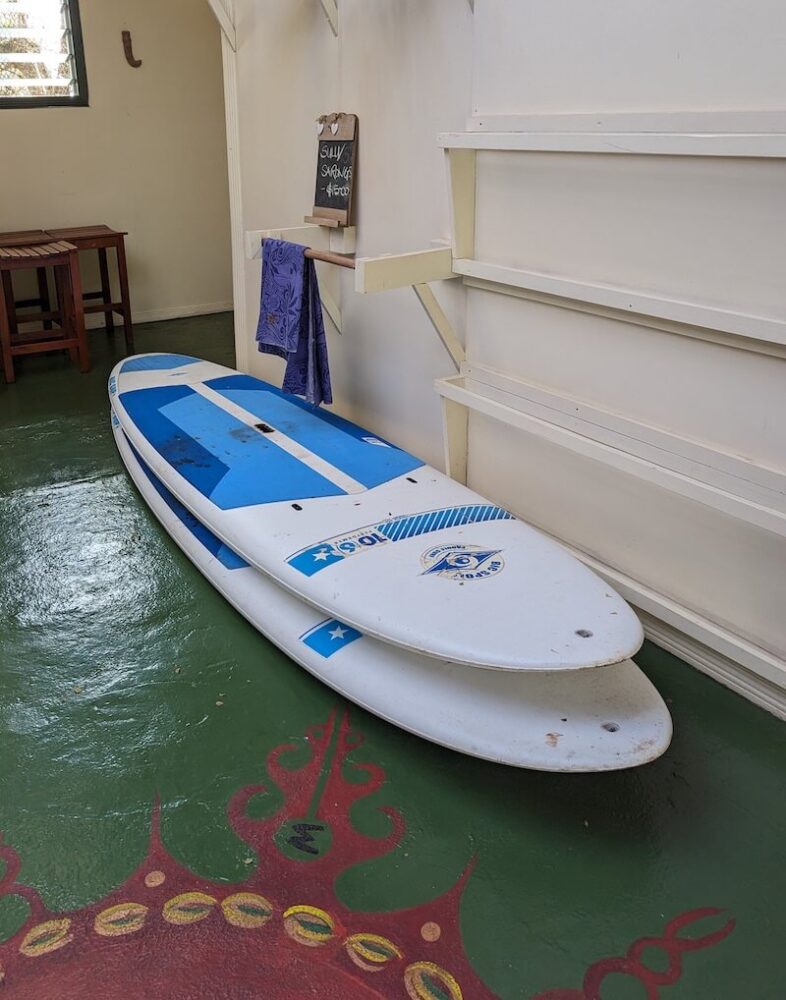
The waters off the town of Matei are really calm and peaceful, making it perfect for exploring by kayak or paddleboard!
You can rent one from a variety of dive shop storefronts along the main road for an affordable hourly or daily price.
Tip: Reserve one for around 5 PM to 6 PM to see the sunset from the water!
Visit the Vuna Blowholes.
One of lesser-known but equally interesting things to do in Taveuni is explore the spectacle that is the Vuna Blowholes.
Located on the southern coast of Taveuni near the village of Vuna, quite literally at the end of the road on the western side, these blowholes are a breathtaking display of nature’s power and beauty.
The Vuna Blowholes are a series of natural openings in the volcanic rock where the force of the ocean waves, combined with the underground pressure, causes water to shoot up dramatically into the air.
On days when the sea is particularly active, these jets of water can reach impressive heights, which is accompanied by the thunderous sound of the waves crashing against the rocks and the hiss of the water spraying into the air as it escapes the tightness of the lava tube.
But the setting of the Vuna Blowholes is perhaps the best part, with its rugged coastline with its sharp cliffs and vast blue ocean behind it.
Visiting the blowholes is relatively easy, with a marked path leading from the nearby village, and there is no entry free. That said, if locals help you along the way, it’s common to to offer a small donation or ‘sevusevu’ to the local village.
This gesture not only supports the community and respects their cultural customs, but also promotes sustainable tourism and shares the wealth of tourism with the locals, not just foreigners who own large resorts.
Explore Des Voeux Peak for birdlife and bird watching.
Another hike you may want to do in Taveuni is up Des Voeux Peak, the second-highest peak on Taveuni at nearly 1,200 meters (3,930 feet).
Due to its height and its difficulty (especially if there’s been rainfall) this is a hike you should only do with a guide.
Also note that because of its height, you should not do this hike on the same day that you are doing diving — which is why we weren’t able to do this when we visited.
You can either take a hike the full 6 kilometers up and down (which takes about 3-4 hours up and 2-3 hours back) — it’s steep and difficult, without a lot of cover in some spots, so be sure to bring a lot of water if you choose this option.
If you do the hike, you can also hire a guide in the local village — I highly recommend this for your own safety!
An easier option is to book a 4WD with a guide. They will bring you a good portion fo the way up the mountain via about a 40-minute drive, and then you only have to hike an additional 30 minutes or so to reach the top of the peak.
This area is one of the most remote, secluded parts of Taveuni so it’s perfect for admiring the island’s endemic birdlife, like the orange fruit dove and the colorful Fiji parrotfinch.
Allow three to four hours to walk the 6 kilometers up, and at least two to return. It is a steep, arduous climb in the heat so it is best to start early.
It is possible to drive (4WD) with a guide part of the way up. It is also possible to pick up a guide from the local village to go with you and this is well worth it for the local knowledge.
Hike in search of the rarest flower in the world.
Did you know Taveuni is the only place in the world where the beloved, rare Tagimoucia flower grows — which also just so happens to be the national flower of Fiji?
You can find it in the volcanic crater of Lake Tagimoucia, but only during certain parts of the year. When I went in July, it was not the season for it.
I was advised that you can find the flower blooming around October through January, peaking in November and December.
You’ll definitely want to hire a guide if you’re hiking to Lake Tagimoucia, since it’s a pretty intense hike, where fog can often obscure paths.
The flower is also smaller and harder to find than you might imagine, so it helps to have an expert with you!
They can also tell you the local Fijian legends about this flower, which supposedly emerged from the tears of a young girl who was crying over a love that was breaking her heart.
Cross the International Dateline… as many times as you want!
Crossing the international date line once is for chumps. Did you know that on Taveuni, you can cross it as many times as you want?
Yes, the international date line runs straight through this island, and you can find the sign for it behind the fire station and rugby field between the towns of Wairiki and Tavuki (near the Waitavala Slides).
While Taveuni may be known for its reefs and waterfalls, one of the quirkiest things to do in Taveuni is cross a simple line drawn on the earth: the International Date Line.
This simple line, passing through the 180° meridian where the East meets the West, lets you play time traveler, playfully juggling ‘yesterday’ and ‘today’ within a matter of seconds.
The fun in visiting the International Date Line is the playful photos and videos you can take, hopping from one side to the other, you can boast that you’ve stepped into tomorrow and then hopped back to today!
It’s also an amusing way to realize the arbitrary nature of time demarcations — because what do you mean that you can be in two days at once if you straddle the line?
That said, although this line theoretically bisects Taveuni, it’s not really the case that half the island is in today and half is in tomorrow — the date line has been adjusted so that it circumvents the entire Fiji archipelago.
It’s more of a fun quirk than an actual date line, but it’s a fun thing to do in Taveuni nonetheless!
Attend a Sunday church service at the Wairiki Catholic Mission.

This Catholic church in Taveuni is a great place to get introduced to Fijian religious customs — it’s a raucous, fun time with lots of singing, a great place to spend a Sunday with locals who sing beautiful hymns a capella.
This Catholic Church is also an interesting place as it stands in tribute to a French missionary who helped Taveuni in a battle against the Tongans, who were trying to invade the island.
It incorporates Roman design, including stained glass windows and stonework, while also having traditional Fijian elements like floor mats instead of pews.
It really shws the hybridization of culture that is emblematic of modern-day Fiji.
The church is also quite close to the International Date Line, so you can easily combine these two things.
Visit the Civa Pearl Farm.
Taveuni is home to a pearl farm where you can learn how they farm pearls from oysters and make beautiful jewelry out of it!
Similar to Tahitian pearls, Fijian pearls are often lustrously black or other beautiful deep colors like green or purple, as opposed to the white pearls you’ll find in other parts of the world.
The owner of the pearl farm, Claude, will bring you out to the pearl farm by boat and explain exactly how they farm pearls here.
The pearl farm tour takes place at 2 PM on Mondays through Thursdays.
And of course, you can buy some beautiful pearls as a souvenir afterwards if you want.
Oh, and you can even snorkel on the reef here if you want!
Get a Fijian massage.
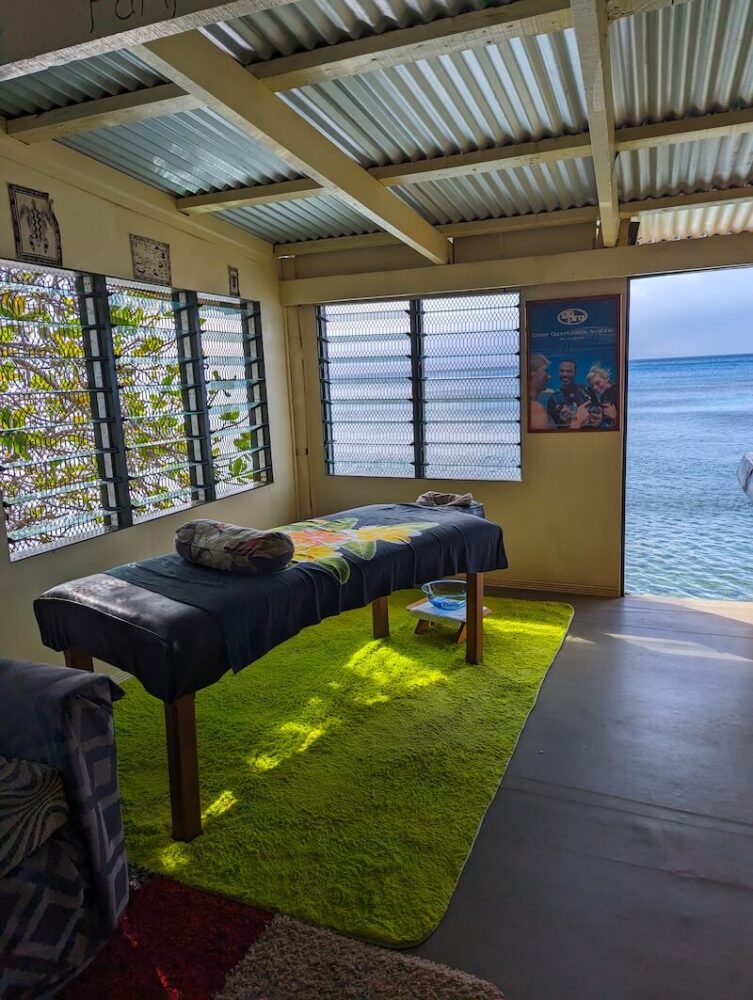
Between all the incredible diving and hiking that Taveuni has to offer, it’s easy to wear yourself down a bit and feel some aching muscles.
Many resorts and hotels will offer in-room massages, but the best deal on the island (and an incredible massage) can be found at the storefront of Taveuni Ocean Sports in Matei.
There, you can get an incredible hourlong massage to the sound of the ocean behind you for just $60 FJD ($26 USD) per hour!
Enjoy the snorkeling and sand beaches of Waitabu Marine Park.
Waitabu Marine Park is a dedicated protected marine reserve where fishing has been prohibited in order to preserve the local ecosystem.
There are two ways you can visit the marine park — there is a Cultural Experience tour that costs $100 FJD ($44 USD).
That includes refreshments, entertainment, and the chance to experience a traditional bilibili ride on a Fijian wooden raft.
Another option is just a snorkeling tour, which costs $70 FJD or $30 USD, where you can explore some of the best reef near the island of Taveuni (not far out like the Rainbow Reef is).
It’s also close to Tavoro Waterfalls so it makes a good addition to a day out at Bouma National Heritage Park.
Stay at one of the epic island resorts.
There are several incredible resorts on Taveuni and its nearby islands, including Qamea Resort and Spa on the island of Qamea and Taveuni Palms Resort on the main island near the airport.
This is a great way to relax and unwind and enjoy some 5-star luxury on the laidback island of Taveuni.
There are also dive resorts like Taveuni Dive Resort in case you want your stay to be more focused on the underwater world than the surface!
Allison Green is a former teacher who has been travel blogging since 2016. She has a Masters in Teaching and a B.A. in English and Creative Writing. Her blog posts merge her background as an educator with her experience traveling to 70+ countries to encourage ethical, meaningful travel. She has been a speaker at the World Travel Writers Conference and her writing, photography, and podcasting work has appeared in National Geographic, CNN Arabic, CBC Canada, and Forbes, amongst others. Now a full-time traveler, she has lived in Prague, Sofia, New York City, and the San Francisco Bay Area.
Found your post to be informative and easy to read. With wonderful clear directions and how to go about it. Looking forward to more Fiji post. Thank you
That’s great Kate! I’m glad this was helpful for your trip to Taveuni, I hope to post more Fiji content soon!
Bula Allison, are you still in Fiji?
Bula! No, unfortunately, I was there in August-September 2023, I left a while ago 🙂